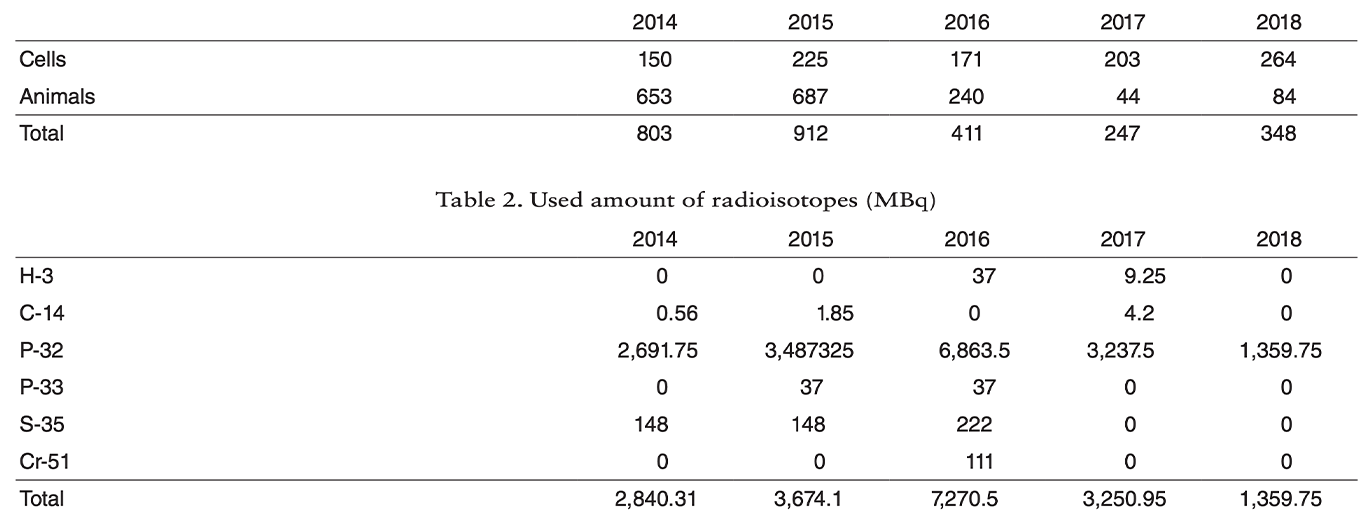Annual Report 2018
Central Radioisotope Division
Masamichi Ishiai, Gen Fujii, Hiroshi Tanooka, Junko Suzuki
Introduction
The Central Radioisotope Division is a joint usage facility composed of the Research Support Core of the Fundamental Innovative Oncology Core (FIOC) of the National Cancer Center (NCC) Research Institute. We provide advanced technical training and education for researchers in the NCC.
The Team and What We Do
Our division manages radioisotope (RI) materials, gamma-ray irradiators (Gammacell 220 with Co-60 source, and Gammacell 40 Exactor with Cs-137 source), and radiation-related equipment. The important role our division plays is in exposure control of the radiation control area.
The facility utilizing information
In 2018, the usage of gamma irradiation (Table 1) increased from 2017. Especially, the cell experiment number increased, compared to prerelocation periods of the Research Institute (2014- 2016). The mouse (animal in the table) experiment number increased from 2017, but it did not recover to the level of pre-relocation period of the Research Institute. The used amount of RI (Table 2) decreased, possibly because of the effect of the temporary interruption to our division owing to the relocation of the Research Institute and the stimulation of the transition from experiments using RI to non-RI experiments.
Table 1. Usage times of gamma-ray irradiation


Future prospects
Recently, live imaging technology for cells and/or animals has been developing, and the usage of radionuclides for molecular imaging such as positron emission tomography (PET) has increased. In the NCC, boron neutron capture therapy (BNCT) has started, and this caused the increase in opportunities to handle neutronirradiated cells in our division. In addition, basic and/or clinical research intended for radionuclide therapy will start. The management, equipment, and education necessary for these new-age radiation technologies for cancer research will be urgently needed in our division.
List of papers published in 2018
Journal
1. Okamoto Y, Abe M, Itaya A, Tomida J, Ishiai M, Takaori-Kondo A, Taoka M, Isobe T, Takata M. FANCD2 protects genome stability by recruiting RNA processing enzymes to resolve R-loops during mild replication stress. FEBS J, 286:139-150, 2019
2. Tamura S, Narita T, Fujii G, Miyamoto S, Hamoya T, Kurokawa Y, Takahashi M, Miki K, Matsuzawa Y, Komiya M, Terasaki M, Yano T, Mutoh M. Inhibition of NF-kappaB transcriptional activity enhances fucoxanthinol-induced apoptosis in colorectal cancer cells. Genes Environ, 41:1, 2019
3. Okamoto Y, Iwasaki WM, Kugou K, Takahashi KK, Oda A, Sato K, Kobayashi W, Kawai H, Sakasai R, Takaori-Kondo A, Yamamoto T, Kanemaki MT, Taoka M, Isobe T, Kurumizaka H, Innan H, Ohta K, Ishiai M, Takata M. Replication stress induces accumulation of FANCD2 at central region of large fragile genes. Nucleic Acids Res, 46:2932-2944, 2018
4. Fujimoto K, Ohta T, Yamaguchi H, Tung NH, Fujii G, Mutoh M, Uto T, Shoyama Y. Suppression of polyp formation by saffron extract in ApcMin/+ mice. Pharmacognosy Research 11(1), 98-101, 2019
